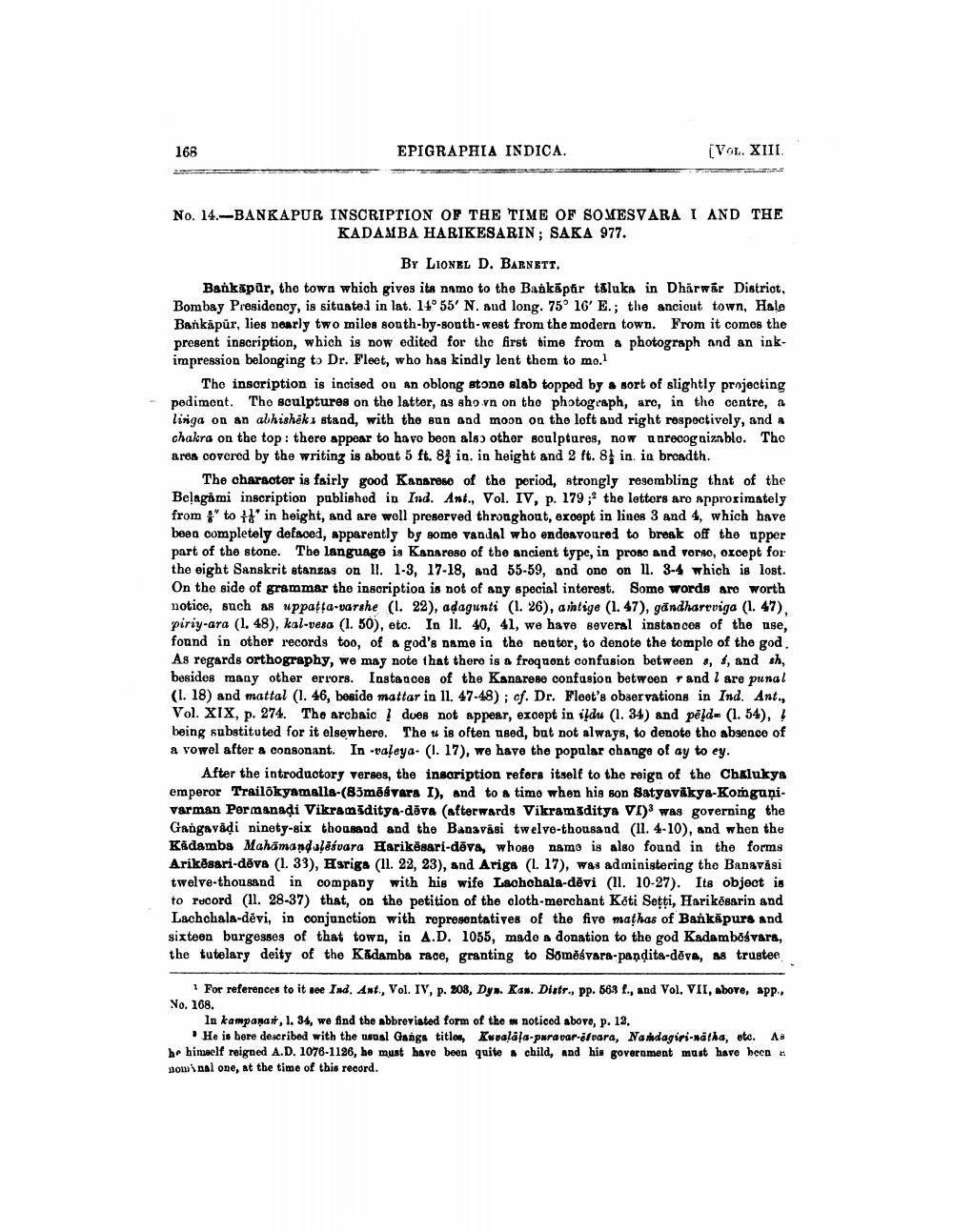________________
168
EPIGRAPHIA INDICA.
(VOL. XIII.
No. 14.---BANKAPUR INSCRIPTION OF THE TIME OF SOMESVARA I AND THE
KADAMBA HARIKESARIN: SAKA 977.
BY LIONEL D. BARNETT. Bankapur, the town which gives its namo to the Bankäpör täluka in Dharwar District, Bombay Presidency, is situated in lat. 14° 55' N. and long. 75° 16' E.; the ancicut town, Hale Bankapur, lies nearly two miles sonth-by-south-west from the modern town. From it comes the present inscription, which is now edited for the first time from a photograph and an inkimpression belonging to Dr. Fleet, who has kindly lent them to mo.
The inscription is incised on an oblong stone blab topped by a sort of slightly projecting pediment. The sculptures on the latter, as sho.vn on the photograph, arc, in the centre, a linga on an abhishēkı stand, with the sun and moon on the left and right respectively, and a chakra on the top: there appear to have beon also other sculptures, now anrecognizablo. The area covered by the writing is about 5 ft. 84 in. in height and 2 ft. 8: in in broadth.
The character is fairly good Kanarose of the period, strongly resembling that of the Belagami inscription published in Ind. Ant., Vol. IV, p. 179;' the lettors aro approximately from " to il' in height, and are well preserved throughout, eroept in lines 3 and 4, which have been completely defaced, apparently by some vandal who endeavoured to break off the apper part of the stone. The language is Kanareso of the ancient type, in proso and vorse, oxcept for the eight Sanskrit stanzas on II. 1-3, 17-18, and 55-59, and one on 11. 3-4 which is lost. On the side of grammar the inscription is not of any special interest. Some words are worth notice, such as uppatta-varshe (1. 22), adagunti (1. 26), antige (1. 47), gāndhartviga (1. 47). piriy-ara (1. 48), kal-vesa (1. 50), etc. In 11. 40, 41, we have several instances of the use, found in other records too, of a god's name in the nentor, to denote the temple of the god. As regards orthography, we may note that there is a froquont confusion between 8, 6, and sh, besides many other errors. Instances of the Kanarese confusion between rand l are punal (1. 18) and mattal (1. 46, besido mattar in 11. 47-48); cf. Dr. Floot's observations in Ind. Ant., Vol. XIX, p. 274. The archaic ! dues not appear, except in ifdu (1. 34) and pēļd(1. 54), ! being substituted for it elsewhere. The u is often used, but not always, to denote the absence of a vowel after a consonant. In taleya. (1. 17), we have the popular change of ay to ey.
After the introductory verses, the insoription refors itself to the reign of the Chalukya emperor Trailokyamalla-(83mēsvara I), and to a time when his son Satyavākya-Kongani. varman Permanadi Vikramiditya dāva (afterwards Vikramaditya VI) was governing the Gangavādi ninety-six thousand and the Banavasi twelve-thousand (11. 4-10), and when the Kadamba Mahamandalösvara Harikësari-dāva, whose name is also found in the forms Arik asri-dēva (1. 33), Hariga (11. 22, 23), and Ariga (1. 17), was administering the Bansvisi twelve-thousand in company with his wife Lachohala-dēvi (11. 10-27). Its object is to record (11. 28-37) that, on the petition of the cloth-merchant Kéti Setti, Harikēsarin and Lachchala-dėvi, in conjunction with representatives of the five mathas of Bankāpurs and sixteen burgesses of that town, in A.D. 1055, made a donation to the god Kadambosvara, the tutelary deity of the Kadamba race, granting to Soměsvara-pandita-déve, as trustee
For references to it see Ind. Ant., Vol. IV, p. 208, Dys. Kan. Distt., pp. 563 f., and Vol. VII, above, app, No. 168.
In kampanar, 1. 34, we find the abbreviated form of the w noticed abovo, p. 12.
He is bere described with the usual Ganga titles, Kwvalála-puravar-olvara, Nandagiri-Natha, eto. Ad be himself reigned A.D. 1076-1126, he must have been quite a child, and his government must have been nominal one, at the time of this record.




